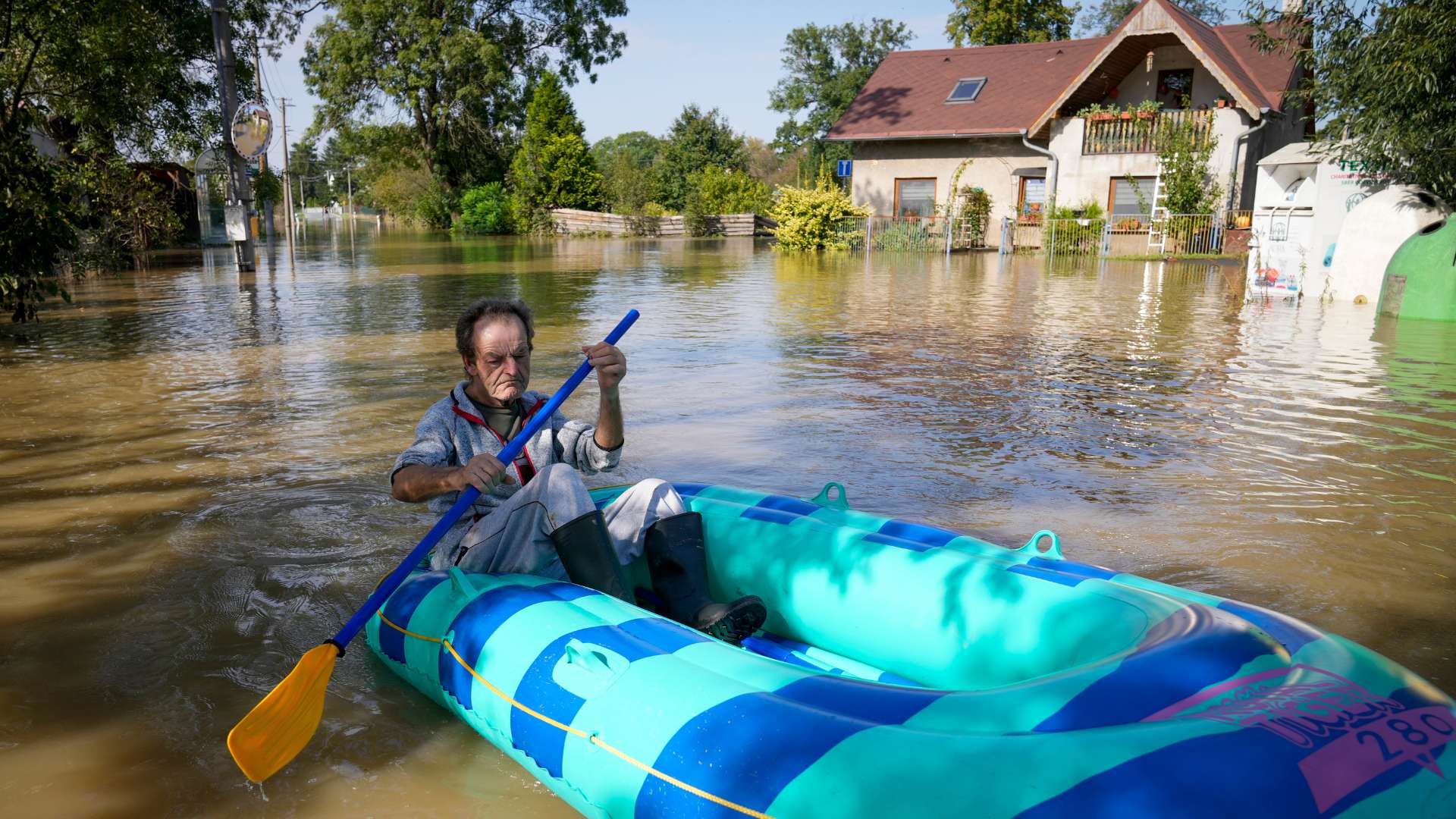Even as different places adapt differently to floods and famine, heat and cold, we have to learn how to cool down our planet together.

A resident paddles through a flooded street in Bohumin, Czech Republic, 17 September 2024. (AP Photo/Darko Bandic)
This article was produced exclusively for News Decoder’s global news service. It is through articles like this that News Decoder strives to provide context to complex global events and issues and teach global awareness through the lens of journalism. Learn how you can incorporate our resources and services into your classroom or educational program.
It was another record breaking summer for the climate.
At least 10 countries recorded temperatures that exceeded 50°C, according to the World Meteorological Society.
Storm Boris brought unprecedented rain to central and eastern Europe. The state of Lower Austria had five times the average September rainfall in only four days and is being dubbed “the catastrophe region.”
While not as big as 2023, wildfires in northern Canada continued to wreak havoc in 2024 — the total area burned this past summer was in the top five in modern record keeping.
The headlines from this summer show that climate change has different impacts. Some places are warmer, which is to be expected. However, some places are wetter and others are drier. Exploring headlines from this past summer can help explain some of these differences and understand what actually can be done.
A summer of extreme weather
For the second year in a row, the global average surface temperature is the warmest on record: 0.7°C warmer compared to the 1991–2020 global average and 0.23°C warmer compared to January through August 2023.
Globally, August 2024 was a record breaking month for the 15th month in a row — a notable statistic, said Dr. Zach Labe, research physical scientist at the U.S. National Oceanic and Atmospheric Administration.
“I think it’s remarkable where it was a second summer, you know, of record heat,” said Labe. “We’re in a period right now with a lot of extremes.”
While looking at the last 15 months of warming and extremes, it might seem like climate change is accelerating. However, short-term weather patterns can’t say much about the climate, which need to be measured over years and decades.
From a long-term climate perspective, temperatures have warmed over time, said Labe.
However, he added, it is difficult to say if climate change has been accelerating in the past 15 months or if the rampant warming is part of the natural variation of temperatures, which can be influenced by various factors, such as El Niño or La Niña, for example, and can influence the current climate.
Floods and droughts
Storm Boris caused the worst flooding in eastern and central Europe in two decades with billions of euros in damage and lost lives.
It might seem counterintuitive that the same summer could have record-breaking heat in some places, and yet be wetter in others.
But there is an answer. In simple terms, warmer air can hold more moisture, said Labe. If there is more moisture in the atmosphere and ocean, there is a higher probability of heavier rainfall. Where this rain falls can be influenced by a number of factors, such as topography of a region.
Other areas experience the effects of climate change in completely different ways.
Canadian summers, for example, have become hotter, windier with more erratic rainfall and lightning. All of these together have contributed to more destructive fire seasons — with experts pointing to climate change as the consequential driving factor.
Extreme weather as the new normal
Another recording-breaking summer is alarming.
Temperatures exceeding 1.5°C for short periods of times or in certain locations does not mean that we’ve now exceeded the limit set by the 2016 international treaty on climate change known as the Paris Agreement. However, it does mean that there’s more to be done to limit the number of recording breaking climate days in the future.
Even if the entire globe stops emitting emissions today, the impacts of climate change will continue to play out. This also means that we need to find ways to adapt to these hotter and more extreme summers that are likely to come.
During summer 2023, southern Europe experienced an extreme heatwave and wildfires across the region. When scientists were interviewed on the news, Dr. Carlo Aall, professor at the Western Norway Research Institute, remembered hearing them say that it is getting drier and warmer because of climate change and we need to put in more fire brigades to help the situation.
But that doesn’t really get to the root of the problem and the vulnerability that societies face in the wake of climate change, Aall, said. Instead of more fire brigades to deal with wildfires once they start, for example, policies that forbid cultivating plants that are vulnerable to drought could help dampen the risk of a wildfire starting altogether in southern Europe.
When it comes to regions that are at risk of flooding, the only way to completely avoid floods in some regions is to relocate, he said. But that won’t be possible in many places for several reasons, such as cost, so it’s best to look for ways to adapt.
“So my sort of advice, and what we can do is to look at how Venice has dealt [with flooding] for hundreds of years,” Aall said. Cities can create buildings that are able to withstand water coming into the bottom floors of houses in flood-prone areas, he added.
Looking to how others around the world have dealt with different extremes can be key for many people adapting to new realities in their own backyards. But tackling climate change in a big way will require radical transformation of society in a big way, said Aall.
“I think it’s about becoming even more scared,” he said, as a way to get people to truly address the root of these problems — not just adapt to them.
Three questions to consider:
- Why does climate change result in floods in some places and droughts in others?
- Why is difficult to tell if climate change is accelerating by looking at recent weather patterns?
- In what ways are you, or anyone you know, changing the way you live because of climate change?

Ashley Perl is a journalist covering climate, energy, science and other stories that catch her interest. She’s based in Stockholm and is originally from Canada.
